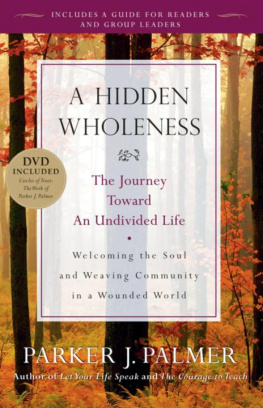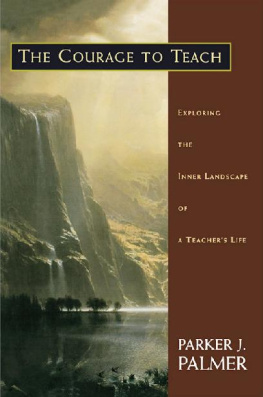My aim in this book, writes Parker J. Palmer in The Active Life,is to celebrate and criticize the active life, to explore its joys and pains, its problems and potentials, to understand the forces that both drive and deform our activitybut to do all this with reverence for the mystery of self-discovery and creation which is at the heart of human action (p. 11). Through a creative exploration of the truths embodied in the imaginative patterns of stories and poems, Palmer mines the riches of diverse traditionsTaoism, Judaism, Christianity, the contemporary struggle for social justicewhile probing the depths of his own experience. With penetrating insight, he guides us into a searching examination of the truth inside us and the truth around us. In the harmony between these two realities, we discover the exhilarating freedom for the active life.
Palmer paints a vision for becoming fully alivea way of living that unites contemplation-and-action. This paradoxical tension brings the strength of self-knowledge to bear upon our relationships with other human beings, nature, and God. Learning right action teaches us to become more honest with ourselves while unveiling the truth of our interconnectedness in the entire community of creation. Palmers culminating vision is the horizon of new life, a resurrection into the great community of justice, truth, and love.
The Active Life challenges us to creative reflection and authentic action as we discover the deep points of connection between self, world, and spirit. In the context of group discussion, it provides opportunities for discovering the gift of community as we learn with each other how to become more aware, more active, more caring human beings.
Harpers series of Leaders Guides provides resources for small adult study groups. Each Guide is based on a widely read book by a well-known and knowledgeable author. Each provides suggestions for forming small groups and for leading the discussions. The Guides also provide discussion questions and other material that can be photocopied for participants.
Harpers Leaders Guides are designed for use in Christian churches of all denominations. However, they may also be used in other settings: neighborhood study groups, camps, retreat centers, colleges and seminaries, or continuing education classes.
Format
Harpers Leaders Guides have been planned as a basis for six one-hour sessions. Six weeks of discussion allows for depth and personal sharing, yet it is a limited commitment, one that busy adults find easier to make.
The Leaders Guides can be adapted for use in other time frames. By combining sessions, you can discuss a book in four meetings. Or, by being very selective with questions, you can plan a single two-hour session. The Guides can also serve as the foundation for a weekend retreat: the six hour-long sessions are alternated with recreation, rest, meals, and other activities.
Forming a Group
Choose a book that you think will be of interest to people in your congregation or other setting. Use your parish newsletter, announcements in services, visits to existing groups, and word of mouth to inform potential participants of the upcoming opportunity. It may be helpful to plan a brief orientation meeting for interested people.
An effective discussion group can be formed with as few as three or four adults joined together by a common interest. If more than twelve people respond, they should probably be divided into smaller groups.
Participants should have access to the books at least a week before the first session. Books may be ordered through your local bookstore or from Customer Service, HarperSanFrancisco, 151 Union Street #401, San Francisco, CA 94111, or call toll-free: 800-328-5125. Plan ahead and allow about six weeks for delivery.
At the time they receive their books, participants should also receive the material found at the back of this Leaders Guide: Materials for Group Distribution. You may photocopy this section to hand out. You may want to distribute all of the materials initially or you may distribute the information one session at a time.
Ask participants to take time to look these over before the session. The prepared discussion questions will serve as a medium to share insights, clarify questions, and reinforce learning.
Helps for Leaders
Be clear in announcing the time and place of the first meeting. If possible, choose a pleasant, comfortable room in which to meet where chairs can be set in a circle. This usually encourages more discussion than a formal classroom setting does.
Choose a leadership style: one person may lead the discussion in all six sessions, or there may be two people who co-lead every session or who alternate sessions. Leadership may also be rotated among the participants.
The Leaders Guide contains several kinds of questions. Some focus on what the book says. Do not neglect these; they are basic to intelligent discussion. These are also good questions for drawing more reluctant members into the discussion. Other questions deal more with the meaning and implications of the authors words. Still others ask participants to share experiences, ideas, and feelings of their own.
In the Leaders Guide you will find sample responses to questions. These are not to be considered the right answers. They are only suggested responses, which often direct you to particular passages in the book. Be open to participants responses that may stray from these suggested answers.
Materials for Group Distribution, found at the back of this Guide, can be photocopied for your group.
Dont feel that you have to get through all the questions and suggested activities in the Leaders Guide. Choose only those that seem most important to your group.
Try to avoid having one or two people monopolize the discussion. Call on some other participants to share their thoughts.
If the group spends too much time on one question, or if it goes off on a tangent, gently call it back to the topic by moving on to another question.
Encourage openness and trust in the group by being willing to share your own thoughts. Try to establish an atmosphere in which all ideas are treated with respect and seriousness.
The Leaders Guide contains some suggestions for group process. Experiment with these, and feel free to adapt them to your particular group.
If you have time, read through The Active Life before your group meets for its first session. Grasping the book as a whole will give you a deeper understanding of it as you move through each chapter with the group. After familiarizing yourself with the book, read through this Leaders Guide, noting the structure of your sessions and the kinds of questions youll be reflecting on together.
Before session 1, read the first two chapters of The Active Life and work through the session 1 discussion questions on your ownwithout relying on the printed comments and suggested responses. You may find it helpful to use a separate notebook for your answers, comments, and questions.
At least a week before the first group session, distribute to each participant a copy of The Active Life and a photocopy of the discussion guide for session 1 at the back of this Leaders Guide. (You may want to hand out all the Materials for Group Distribution at this time. ) Ask participants to read chapters 1 and 2 of









